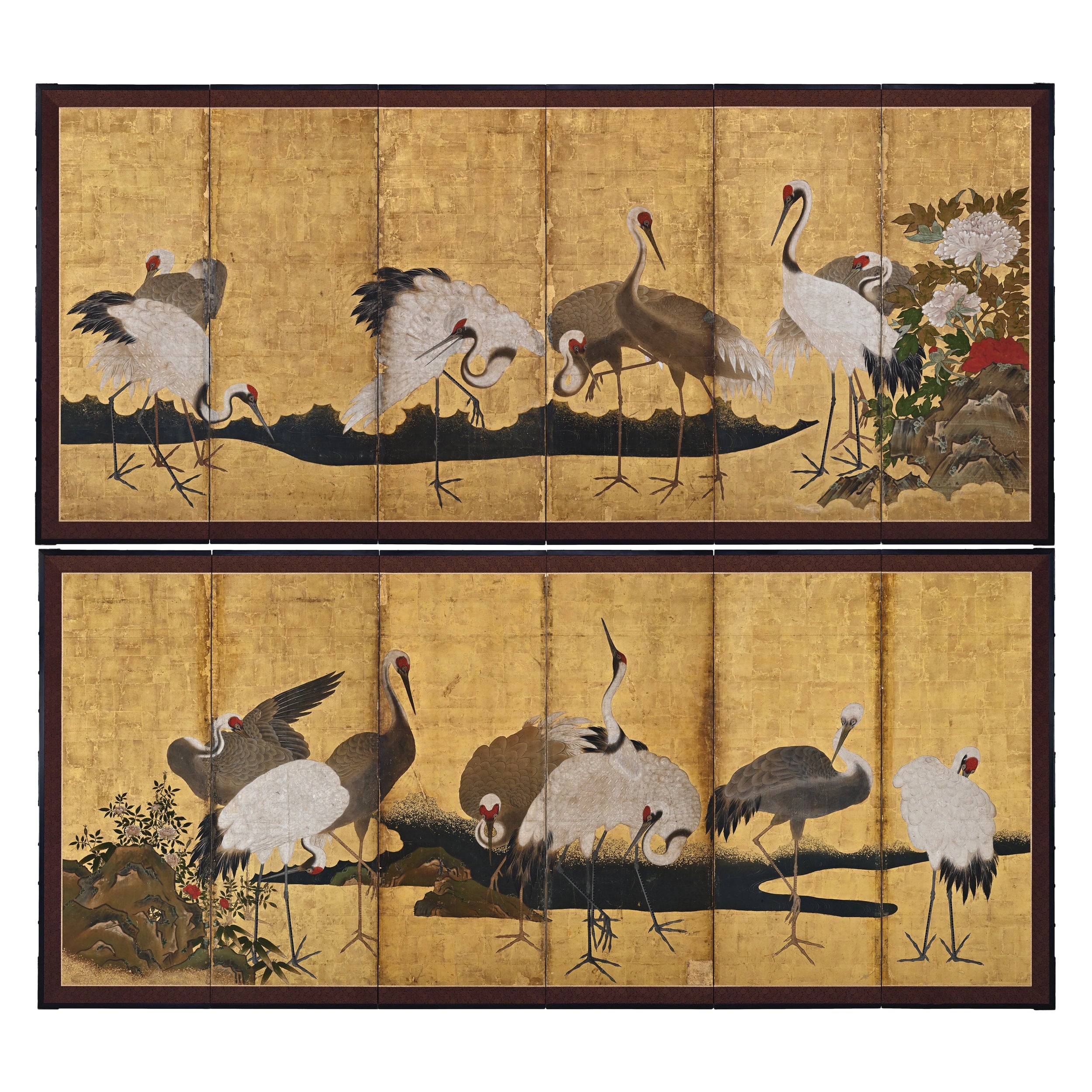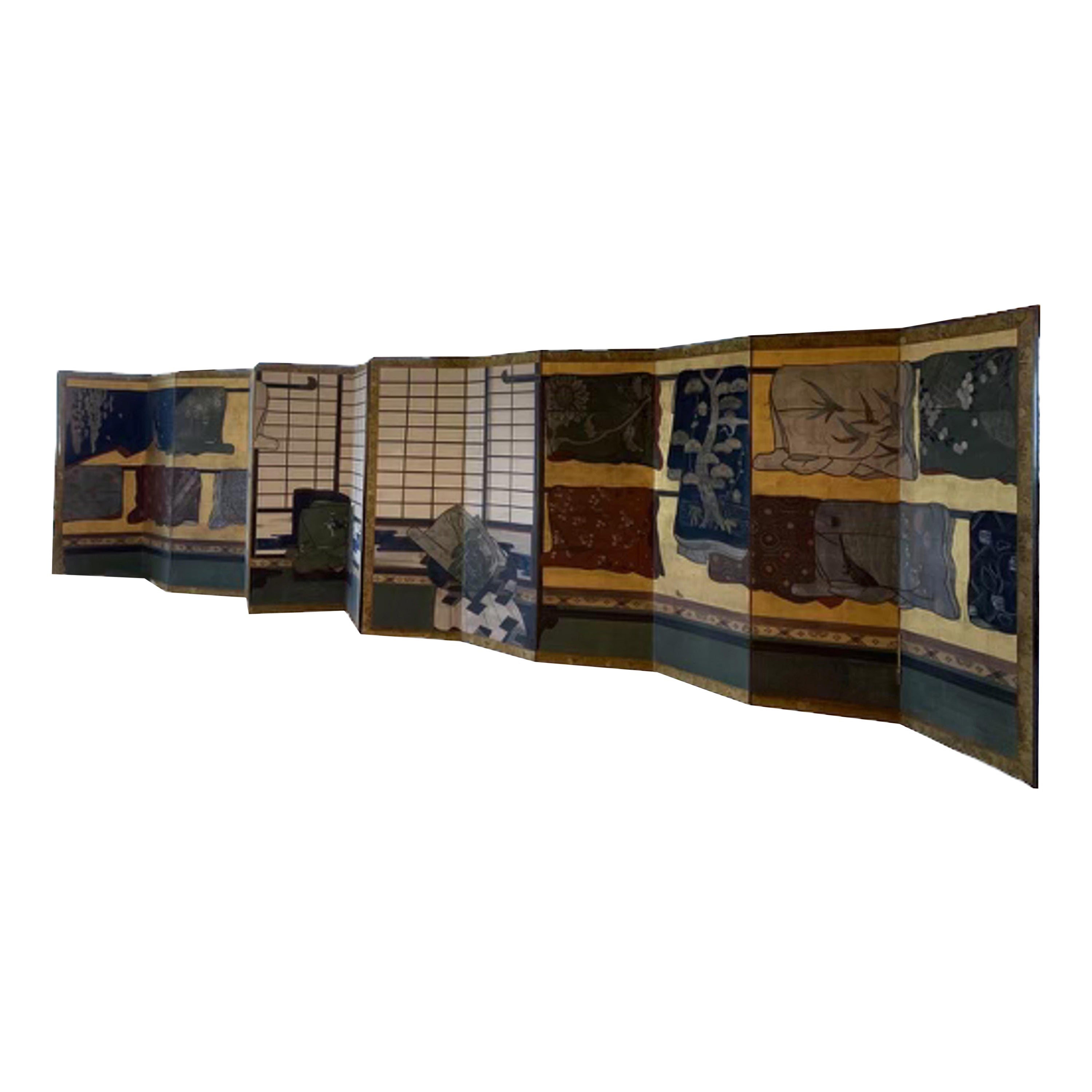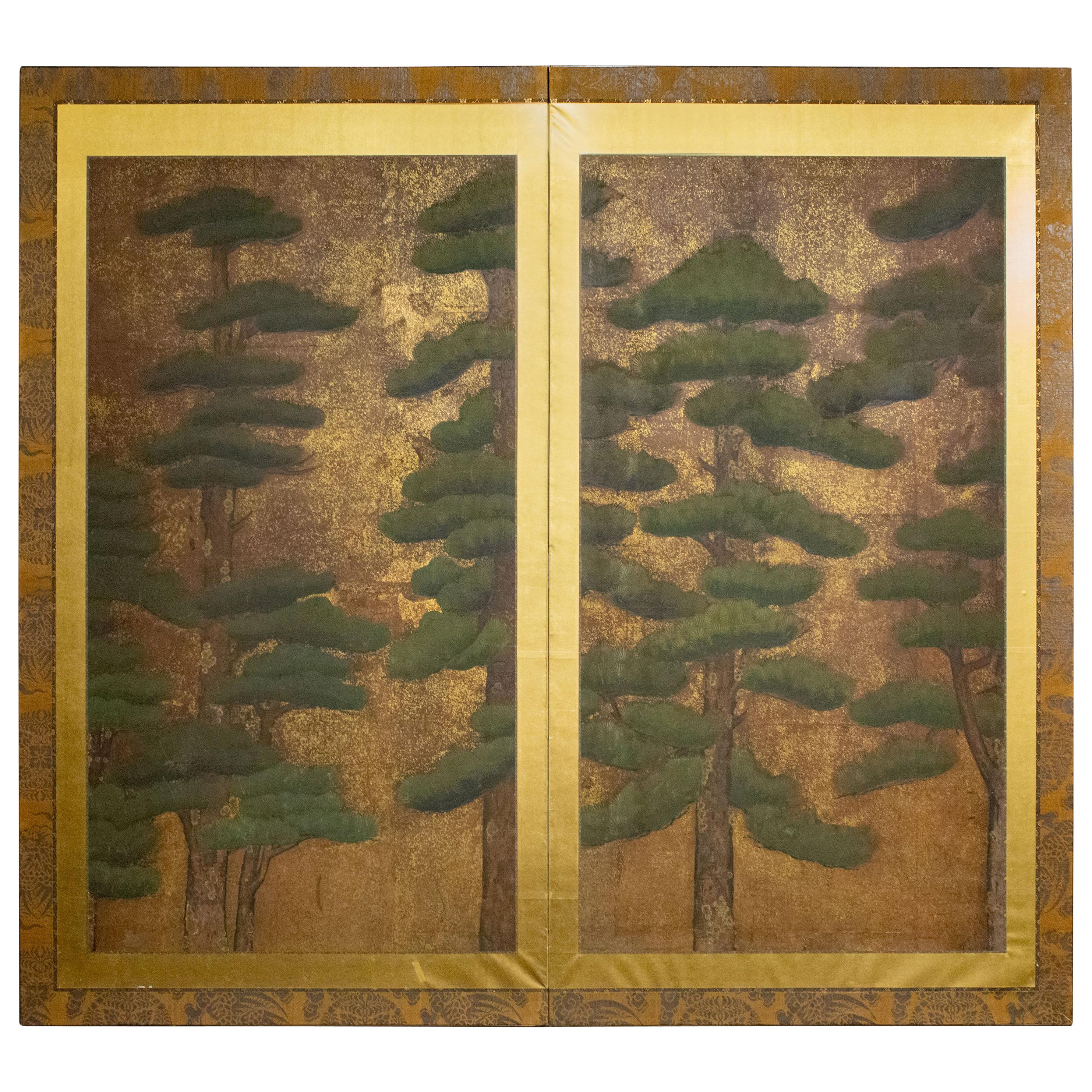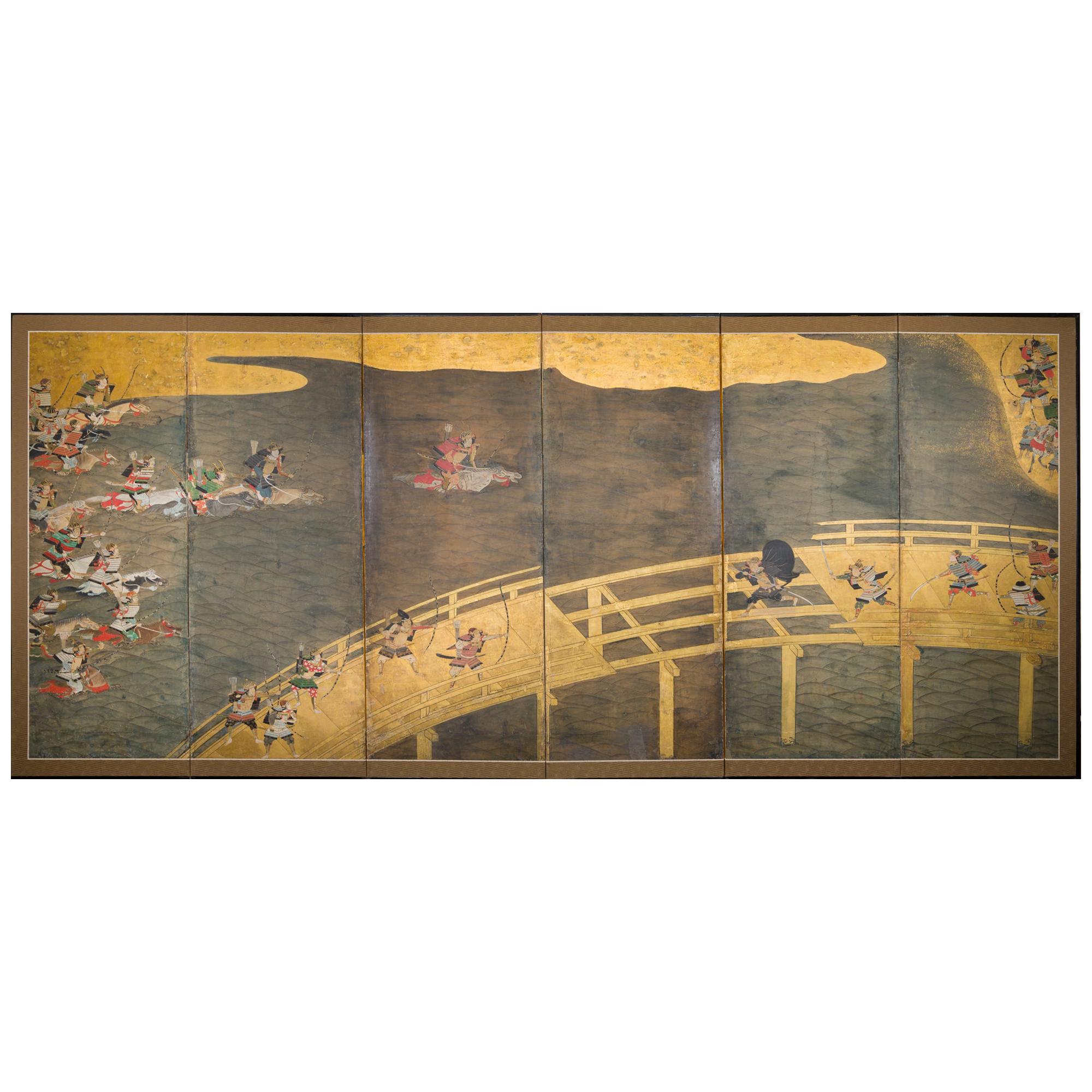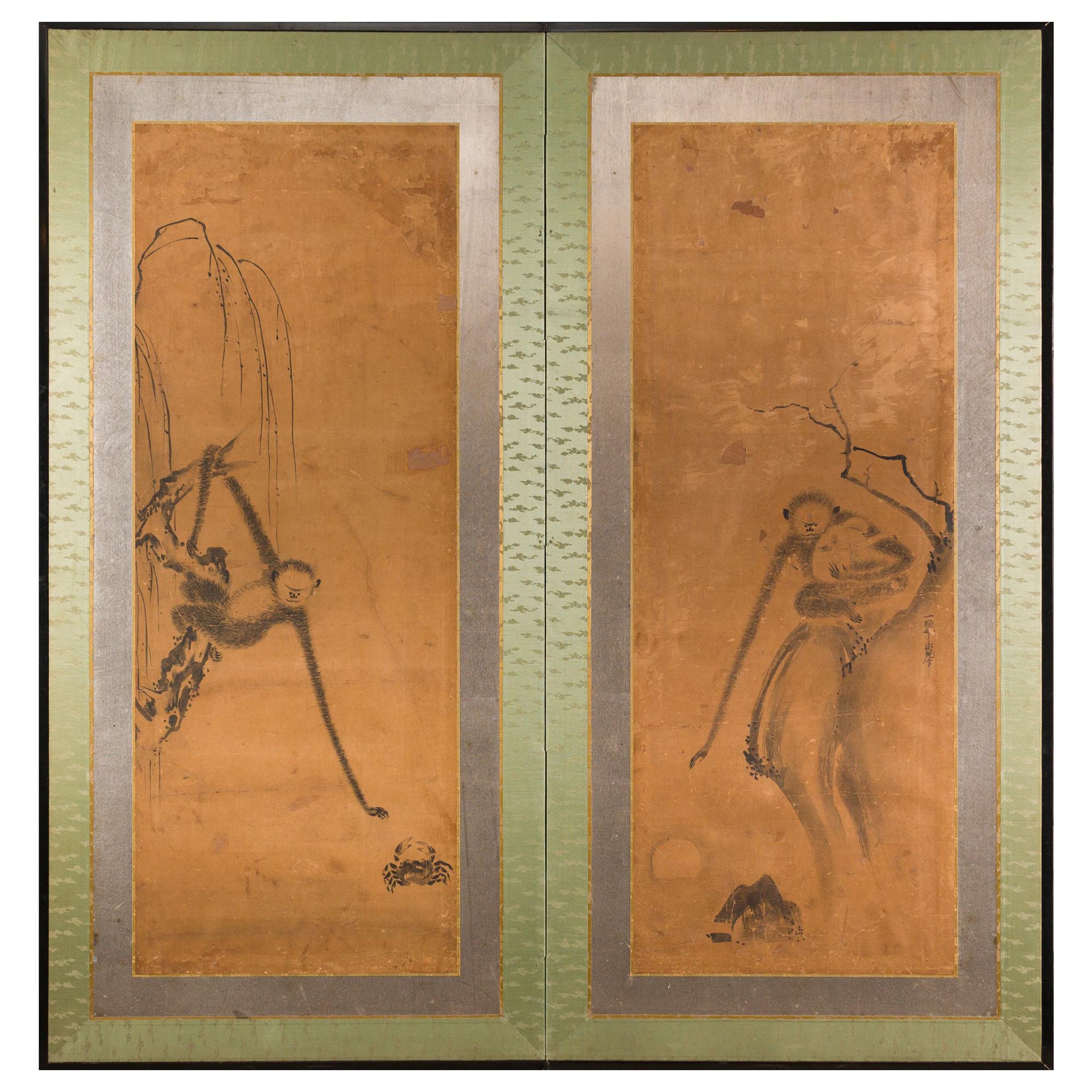Items Similar to Late 17th Century Japanese Screen. Puppy and Kittens on Gold Leaf.
Want more images or videos?
Request additional images or videos from the seller
1 of 10
Late 17th Century Japanese Screen. Puppy and Kittens on Gold Leaf.
About the Item
Anonymous
Late 17th century
Puppy & Kittens
A six-panel Japanese screen. Ink, color, gofun, gold-leaf and gold-fleck on paper.
A medium sized late 17th century Japanese screen featuring a playful narrative scene with a puppy and four kittens. The puppy, adorned with a red ribbon and medallion, is pictured prancing toward the nonchalant group of kittens. The exuberance and movement of the puppy is contrasted against the stillness and nonchalance of the kittens. The distortion and exaggeration of the spotted and speckled kittens resembles the art of caricature; producing animated characters with a comical effect. Blooming in the field are Japanese violets (sumire), Dandelions (Tanpopo) and Japanese field horsertail (Tsukushi). These small flowers denote the season of spring, allowing us further insight into the mood of the scene. The strong and simplified geometric plain is delineated with gold leaf in the upper field and tsunago or gold flecks in the lower field.
Far from the modern age with its more precise awareness of realistic sketching, these cats and dogs were inspired by Chinese paintings from the 12th century Song dynasty. These were kept in Japan with the Shogunate and in temples and circulated amongst the heads of the Kano schools of painting. Given the age of the screen and its likely Kano school origins the imagery would have held strong auspicious meaning. As a painting subject, although not as common as other auspicious animal imagery, dogs generally conveyed ideas of prosperity, family harmony, and fertility; thus they were often portrayed in familial groups or as puppies playing. Dogs were also featured as the animals with the closest relationship to humans, hence the ribbon on the puppy. Cats, as well as being depicted as charming and cute creatures, have also been associated with fertility and family well-being.
The screen bears a signature which reads Douo hitsu, which simply means painted by Douo. It is quite unusual that it is without any seals of the artist and may well be a later, spurious addition to the screen.
- Dimensions:Height: 44 in (111.76 cm)Width: 119 in (302.26 cm)Depth: 0.75 in (1.91 cm)
- Style:Edo (Of the Period)
- Materials and Techniques:
- Place of Origin:
- Period:Late 17th Century
- Date of Manufacture:Circa 1680
- Condition:Refinished. Wear consistent with age and use. The screen has recently been completely remounted in Kyoto utilizing traditional craftsmen and techniques.
- Seller Location:Kyoto, JP
- Reference Number:1stDibs: LU2472336574172
About the Seller
5.0
Recognized Seller
These prestigious sellers are industry leaders and represent the highest echelon for item quality and design.
Gold Seller
These expertly vetted sellers are highly rated and consistently exceed customer expectations.
Established in 2001
1stDibs seller since 2016
60 sales on 1stDibs
Typical response time: 6 hours
- ShippingRetrieving quote...Ships From: Kyoto, Japan
- Return PolicyA return for this item may be initiated within 10 days of delivery.
More From This SellerView All
- 17th Century Japanese Screen Pair, CranesLocated in Kyoto, JPCranes Anonymous, Kano School. Edo period, second half of the 17th century. Pair of six-panel screens. Ink, pigment gofun and gold l...Category
Antique 1670s Japanese Edo Paintings and Screens
MaterialsGold Leaf
- 17th Century Japanese Screen. Karako Asobi: Chinese Children at Play.Located in Kyoto, JPAnonymous Kano school artist 17th century "Karako Asobi: Chinese Children at Play" A two-panel Japanese Furosaki screen. Ink, pigment, gofun and gold-leaf on paper. This small Japanese Karako folding screen vividly depicts various games played by children wearing wearing elaborate Chinese T'ang dynasty costumes. They are dressed in plumed and tasseled hats, ornate jackets, baggy pants, and cloth slippers typical of T'ang period Chinese court dress. The children are depicted pulling a younger child along in a cart, carrying another child as if an important official, riding a wooden horse, leading a puppy and carrying a tethered bird. Executed in fine-quality pigments on gold leaf, the detail, variety and size of the figures is noteworthy. Also notable is the size of this screen itself, which denotes it as a Furosaki screen. A Furosaki screen is part of the equipment used for the Japanese tea-ceremony. It is traditionally placed on tatami mats behind the brazier highlighting the utensils and providing a focal point. Karako is a Japanese term used in art with the depiction of Chinese children playing...Category
Antique 17th Century Edo Paintings and Screens
MaterialsGold Leaf
- 17th Century Japanese Screen Pair. Tiger & Dragon by Kaiho YusetsuLocated in Kyoto, JPKaiho Yusetsu (1598-1677) Tiger and Dragon Early Edo Period, Circa 1650 A Pair of Six-fold Japanese Screens. Ink and slight color on paper. Dimensions: Each screen: H. 171 cm x W. 380 cm (67.5’’ x 149.5’’) In this pair of early Edo period Japanese screens a group of tigers prowl in a bamboo grove whipped with fierce wind, while a dragon claws through clouds and mist. The dragon embodies elemental qualities - looming out of the mist, the coils of its body disappearing in the clouds. The dragon is calling for rain, symbolizing spring which is considered the fountain of life. On the other side, the tigers calls for the wind, symbolizing autumn which is considered the end of life. Tigers were familiar motifs within Japanese art from ancient times though the animals were imaginary to the people in the 17th century. While dragons and tigers are usually associated as sacred and ferocious, in this painting, both animals have rather amusing expressions. The tigers appear to glare at the dragon with cat-like eyes, and the look on the swirling dragon’s face appears almost affectionate - lending a playful flair to an otherwise magnificent theme. The tiger and dragon are cosmological symbols of the balancing forces in the world. Screens such as this were originally meant to express the fluctuating nature of the world. For Japanese in the early Edo period, they likely suggested the powers of the cosmos. In Japan the tiger and dragon motif was originally absorbed into the circles of Zen monasteries before spreading into the secular world. The theme especially appealed to the military classes with the Kano school, the official painters to the Shogun and the samurai, being the leading contributors. The painter of this pair of screens, Kaiho Yusetsu (1598-1677), was closely patronized by the third Shogun Tokugawa Iemitsu. In his later years he worked with Kano school artists...Category
Antique Mid-17th Century Japanese Edo Paintings and Screens
MaterialsSilk, Wood, Paper
- 17th Century Japanese Screen Pair by Soga Nichokuan, Hawks on Pine & Plum TreesLocated in Kyoto, JPHawks on plum and pine Soga Nichokuan (active circa 1625-1660) Pair of six-fold screens. Ink, mineral pigments, gofun, gold and speckled gold leaf on paper. Upper seal: H...Category
Antique 1640s Japanese Edo Paintings and Screens
MaterialsWood, Paper
- Japanese Screen, 19th Century, Rabbits and Horsetail Reeds on Silver LeafBy NenmaLocated in Kyoto, JPUnknown artist Rabbits and Horsetail Reeds Painted in the Year of the Fire Dog, 1826 or 1886. 19th century. The scene depicted here is set under moonlight, with two hares hi...Category
Antique Mid-19th Century Japanese Edo Paintings and Screens
MaterialsSilver Leaf
- 17th Century Japanese Screen. Ink Plum Tree & Birds by Kano Naonobu.Located in Kyoto, JPKano Naonobu (1607-1650) Plum Tree and Birds Six-fold Japanese Screen. Ink and slight color on paper. In this evocative ink work spread over a six-panel folding screen, we see the consummation of the elegance and refinement of the Edo Kano school. This 17th century screen is a rare surviving example of a large-scale bird and flower painting by Kano Naonobu, the younger brother of Kano Tanyu...Category
Antique 17th Century Japanese Edo Paintings and Screens
MaterialsWood, Paper
You May Also Like
- 17th Century 'Late 1600s', Japanese Edo Period 12-Panel Folding Screen PaintedLocated in North Miami, FLA pair of 17th Century (Late 1600s) Japanese Edo screens made of 12-panels. This folding silk screen is painted on a gold leaf background. It has a...Category
Antique 17th Century Japanese Edo Paintings and Screens
MaterialsSilk, Wood, Paint, Paper
- Japanese 17th Century Two Panel Screen, Pine with Gold DustLocated in Hudson, NYBeautiful 17th century painting of pine trees. Painting in good condition on 19th century mounting. Mineral pigments and gold dust on mulberry paper w...Category
Antique 17th Century Japanese Edo Paintings and Screens
MaterialsPaper
- Late 17th-Early 18th Century Japanese Six-Panel Screen, Battle at Uji BridgeLocated in Hudson, NYJapanese six-panel screen: Battle at Uji Bridge, the first battle at Uji was in 1180 and it marked the start of the Heike Wars. The Genji troops crossed the...Category
Antique Late 17th Century Japanese Edo Paintings and Screens
MaterialsGold Leaf
- 17th Century Japanese Two-Panel Screen, Gibbons of FolkloreLocated in Hudson, NYJapanese two-panel screen: Gibbons of Folklore, Edo period (17th century) Kano School painting of gibbons in Japanese fables. The left panel represents a Japanese fable of a monkey a...Category
Antique Late 17th Century Japanese Edo Paintings and Screens
MaterialsSilk, Wood, Paper
- 17th Century Japanese Edo Four Panel Screen Hotei with Chinese SagesLocated in Rio Vista, CABeautifully weathered late 17th/early 18th century Japanese edo period four panel byobu screen depicting hotei (fat monk) in a treed landscape with Chinese sages engaged in leisurely...Category
Antique 17th Century Japanese Edo Paintings and Screens
MaterialsBrass
- Six-Panel Japanese Screen on Spring Gold LeafLocated in Brescia, ITSpring landscape by an unknown painter of the Rinpa school, 19th century, six-panel ink painted on gold leaf on rice paper. The flowers are made with the "gofun" technique, natural or pigmented white oyster powder. Rinpa (? ?, Rinpa) is one of the major historical schools of Japanese painting. the style was consolidated by the brothers Ogata Korin (1658–1716) and Ogata Kenzan...Category
Antique Late 19th Century Japanese Edo Paintings and Screens
MaterialsGold Leaf
Recently Viewed
View AllMore Ways To Browse
Small Japanese Kano Screen
Chinese Screen 17th Century
Gold Screen
Japanese Antique Screens
17th Century Japanese Six Panel Painting
Japanese Furniture 17th Century
Japanese Goldfish
Asian Art And Screens
Chinese Gilded Screens
Silk Horses Asian
Egret Screens
Jain Buddha
Silver Japanese Screen Painting Panel
Japanese Sparrow
Battle Of Yashima
Seiko Moon
Soapstone Pagoda
Marble Screen Chinese Natural Stone Painting
